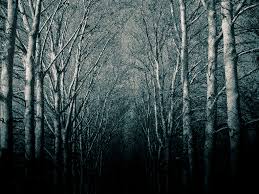Did you know human beings cannot see in pitch darkness? Why?, you ask. Well, apparently because the retinal nerves in our eyes require at least some light to perceive something in the dark. Comforting thought, huh?
So how the heck are we going to protect ourselves in the dead of night when traveling on foot, if we can't see a thing? How are we going to avoid detection from the Golden Horde (i.e. predators - four legged and two legged)? That is, without the help of a pair of costly night vision goggles.

In a survival situation, you almost have to consider every person you see or meet as a stranger … or a danger to you and your supplies, just as you would when walking alone under normal circumstances. Eye everything with suspicion.
So, without the normal "darkness safety precautions" how the heck do we walk in the dark and see where we are going? I can barely get up and go to the bathroom in the dark without taking out a toe or elbow, and we are only talking maybe few feet away from the bed?!
So I began digging, trying to find out what I could do, if I ever had to leave my home in the middle of the night on foot. And what I found was pretty amazing.
Our eyes are actually equipped to see in low light. We have these cells in our eyes called "rod cells" that are made for low light vision and detecting movement.
Have you ever been typing and/or working on your computer and saw movement out of the corner of your eye. That was your rod cells at work. One way you can help train yourself to see better in the dark (or low light) is to go out at night, and not look directly at the place you are trying to see. I know, sounds weird, huh? But, what you are doing, is using your peripheral vision - or your the rod cells.
Another way you can train, is to stand in the darkness and close both eyes really tight. This gives your eyes a chance to adjust to the dark. Then avoid looking directly at any light source as it takes longer to adjust back for the dark than it does to adjust to the light.
By scanning your eyes back and forth over the area you use different areas of the "rods" in your eye. This will help you see details clearer.
You can also close your eyes tightly and apply slight pressure with your palms to both eyes, and hold them for about 10 seconds. With your eyes still closed you will see white for a few seconds then it will go back to black. This resets your vision (kinda like resetting your trip meter in your car). When you open your eyes your vision will be significantly better in the dark. Even the Special Forces use this technique of squeezing their eyes shut tightly for ten seconds - once they are in the dark - again if they aren't wearing those awesome GPNVG that cost around 65k each. (Not foreseeing having a pair of those anytime in the near future ... or not so near future either.
Whatever you do, avoid looking directly at light sources while navigating in the dark. Even using a pen light close to your face can provide enough light to cause your pupils to contract, therefore killing your night vision.
Now along with adjusting your eyes for walking in the dark there are also techniques you can use for your body as well.  Move slowly (we are talking about total darkness here). Also, slide your feet, using your toes to sense obstacles in front of you. And, when I say slide, I'm not saying “shuffle” your feet. The difference being – shuffling can create noise wherein sliding your feet. Slide as in gliding – you know gracefully to have more control.
Move slowly (we are talking about total darkness here). Also, slide your feet, using your toes to sense obstacles in front of you. And, when I say slide, I'm not saying “shuffle” your feet. The difference being – shuffling can create noise wherein sliding your feet. Slide as in gliding – you know gracefully to have more control.
Also, you could extend your arms out in front of you. If you put your arms out, and cross them at the wrists; forming a circle with your elbows out to the sides, it will help keep your balance and help you avoid walking into something … say a tree truck (ouch!). Yes, I'll admit just visualizing someone shuffling their feet while arms extended out can conjure up a pretty funny imagine - but think safety. Remember, we are talking walking in the dark to avoid detection. You will have your Bug-out/Emergency bag with you and possibly other things in your hands and strapped to you. Although it may seem safer to walk in the dark to get to a safe destination, you need to weigh out the pros and cons for your specific situation and location.
If the golden horde (the not so nice people) are sleeping at night and traveling in the day, maybe its a good idea to try doing the opposite and make time in the veil of darkness. Sleep by day and travel by night.
Just remember, you may not be the only one who has this same thought about being out at night. Night time is prime for predators - again both four legged and two legged. Just sayin'.
- Survivor Jane

Thank you for sharing Survivor Jane with your friends!
For more information on Survivor Jane recommended products and services click on Survival Products above.
If you have any questions, or would like to see a specific article addressing survival preparedness for women on SurvivorJane.com click here

